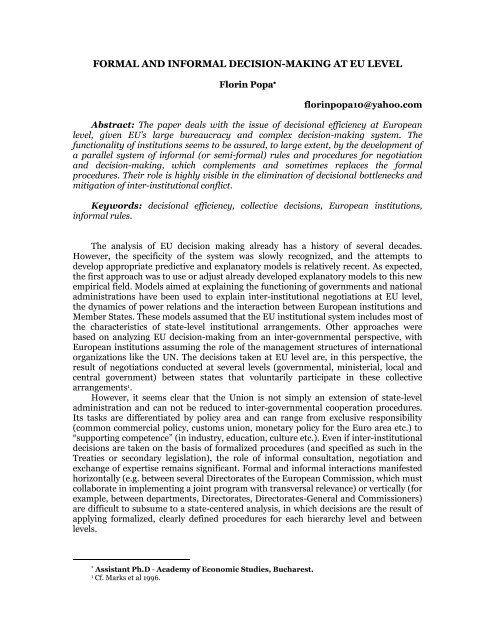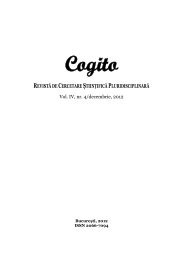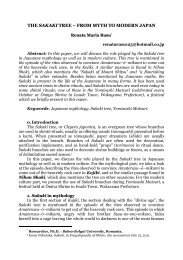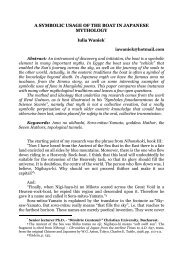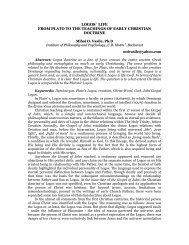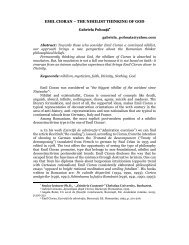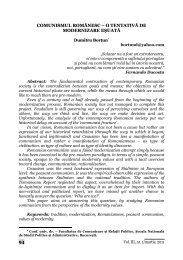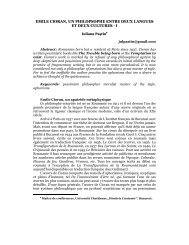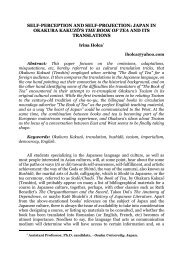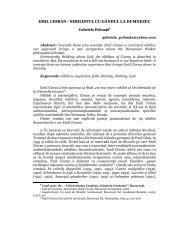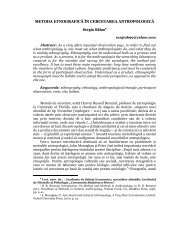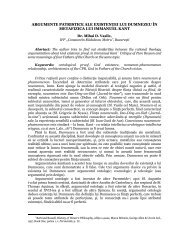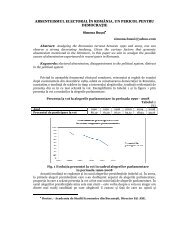FORMAL AND INFORMAL DECISION-MAKING AT EU LEVEL - cogito
FORMAL AND INFORMAL DECISION-MAKING AT EU LEVEL - cogito
FORMAL AND INFORMAL DECISION-MAKING AT EU LEVEL - cogito
- No tags were found...
Create successful ePaper yourself
Turn your PDF publications into a flip-book with our unique Google optimized e-Paper software.
<strong>FORMAL</strong> <strong>AND</strong> IN<strong>FORMAL</strong> <strong>DECISION</strong>-<strong>MAKING</strong> <strong>AT</strong> <strong>EU</strong> <strong>LEVEL</strong>Florin Popa ∗florinpopa10@yahoo.comAbstract: The paper deals with the issue of decisional efficiency at Europeanlevel, given <strong>EU</strong>’s large bureaucracy and complex decision-making system. Thefunctionality of institutions seems to be assured, to large extent, by the development ofa parallel system of informal (or semi-formal) rules and procedures for negotiationand decision-making, which complements and sometimes replaces the formalprocedures. Their role is highly visible in the elimination of decisional bottlenecks andmitigation of inter-institutional conflict.Keywords: decisional efficiency, collective decisions, European institutions,informal rules.The analysis of <strong>EU</strong> decision making already has a history of several decades.However, the specificity of the system was slowly recognized, and the attempts todevelop appropriate predictive and explanatory models is relatively recent. As expected,the first approach was to use or adjust already developed explanatory models to this newempirical field. Models aimed at explaining the functioning of governments and nationaladministrations have been used to explain inter-institutional negotiations at <strong>EU</strong> level,the dynamics of power relations and the interaction between European institutions andMember States. These models assumed that the <strong>EU</strong> institutional system includes most ofthe characteristics of state-level institutional arrangements. Other approaches werebased on analyzing <strong>EU</strong> decision-making from an inter-governmental perspective, withEuropean institutions assuming the role of the management structures of internationalorganizations like the UN. The decisions taken at <strong>EU</strong> level are, in this perspective, theresult of negotiations conducted at several levels (governmental, ministerial, local andcentral government) between states that voluntarily participate in these collectivearrangements 1 .However, it seems clear that the Union is not simply an extension of state-leveladministration and can not be reduced to inter-governmental cooperation procedures.Its tasks are differentiated by policy area and can range from exclusive responsibility(common commercial policy, customs union, monetary policy for the Euro area etc.) to“supporting competence” (in industry, education, culture etc.). Even if inter-institutionaldecisions are taken on the basis of formalized procedures (and specified as such in theTreaties or secondary legislation), the role of informal consultation, negotiation andexchange of expertise remains significant. Formal and informal interactions manifestedhorizontally (e.g. between several Directorates of the European Commission, which mustcollaborate in implementing a joint program with transversal relevance) or vertically (forexample, between departments, Directorates, Directorates-General and Commissioners)are difficult to subsume to a state-centered analysis, in which decisions are the result ofapplying formalized, clearly defined procedures for each hierarchy level and betweenlevels.∗ Assistant Ph.D - Academy of Economic Studies, Bucharest.1Cf. Marks et al 1996.
At institutional level, the explanatory models based on rational choice theory aim toanswer the question "what ensures the effectiveness of some institutions in relation toothers?". They take into account, for instance, transaction costs (those implied by intrainstitutionalinteractions or networking with other organizations), the role of leadershipin motivating organization members, but also the gradual development of a set ofinstitutional arrangements that seem to ensure the "reasonableness" of collective action(in the sense of their adequacy to institutional objectives) 2 . But trying to represent thecomplexity of institutional intra- and inter-relationships within this theoretic frameworkfaces many problems. Treating institutions as collective rational agents, who pursuegoals and preferences and systematically try to maximize their benefits, largely ignoresthe fact that the rationality of individual decision makers and aggregate institutional"rationality" are not the same thing. Moreover, the latter can not be simply reduced tothe first, as shown by Arrow's impossibility theorem 3 . Also, we have to consider theunintended effects and the potential effects of composition of the participants' decisions,which may escalate due to "cascading" and unpredictable dynamics. They are notreducible to accidental failures, but rather illustrate the fundamental difficulty ofensuring an optimal representation of the participants' individual interests in the contextof their interdependence."An institution is based on a dynamic set of negotiations between those players whoset the rules, those who implement them and those who must obey. Their cooperation ismutually reinforcing; the successful fulfillment of one actor's institutionalresponsibilities depend on what the others will do" 4 . However, individual rationality andresponsibility do not guarantee collective efficacy; institutions may fail despite thequality of their personnel or management. The question is whether the functionality andpartial success (at political and administrative level) of Community institutions is theresult of a systematic political project voluntarily undertaken - a "road map" followed bythe main decision-makers - or is rather the changing result of ongoing negotiations,carried at different levels and involving a diversity of actors, which refer to a set of openendedand partially overlapping projects.The concept of integration behind the <strong>EU</strong>’s complex institutional and legislativeframework is based on the attempt to gradually develop a common space based onshared values, practices, policies and administrative structures, where people, products,services and ideas can circulate freely. It is a type of soft integration, which aims todevelop a commitment to specific values, practices, attitudes and norms, in addition todeveloping a political and administrative infrastructure. In <strong>EU</strong>’s case, this concept ofintegration can be illustrated by the diversity of decision-making procedures applicable(depending on the policy area concerned) and the diversity of stakeholders (includingcivil society). An example is the application of the so-called open method of coordination(OMC), whereby several Member States are trying to achieve, through voluntaryintergovernmental cooperation, an agreement on policy areas where Europeaninstitutions cannot act or have a very limited degree of intervention - for example, socialpolicy and employment. OMC calls for coordination based on self-imposed performancestandards, benchmarks, indicators and examples of good practice. While all MemberStates are bound by the <strong>EU</strong> primary legislation, some of them they may, through directnegotiations, agree to jointly pursue objectives beyond those set by the founding treaties.2Cook şi Levi, 1990, 13 şi urm.3Arrow 1951.4Ibid, 14.
A more nuanced perspective on the <strong>EU</strong>'s institutional system is provided by themulti-level governance (MLG) model 5 . It was developed as an alternative to thedominant approach (which considers trans-national institutions as essentially similar tostate institutions, and the inter-institutional relations as being reducible to intergovernmentalprocedures). According to the MLG approach, political and institutionalactors operating at <strong>EU</strong> level have multiple, partial and overlapping competences. Assuch, the main focus shifts from the study of intra-institutional relations and practicestowards the analysis of inter-institutional mechanisms. The partial overlapping of rolesand powers implies that decisions are the result of a negotiation process in whichdifferent interests and levels of authority faces confront and limit one another, causingmutual adjustments. Governments are just one category of actors involved in this multilevelinteraction, which include local authorities, NGOs, trade unions and other forms ofcollective representation of interests. As such, "the state is no longer considered theexclusive channel through which the interests of domestic political actors are expressed/.../. Rather, the arenas are interconnected, with direct and indirect networks betweenthe sub- and supranational levels, which "bypass" the state” 6 . The hierarchical nature ofmodels which analyze transnational cooperation in terms of inter-governmentalrelations gives way to an approach whereby the unidirectional “instruction” (from stateauthorities to regional and local organizations) is replaced by dialogue and negotiationbetween participants. These participants have unequal political influence, but they areequal in terms of the basic rights and obligations assumed by the free participation inthis negotiation. This "institutional mutual dependence" can not be properly analyzed interms of an institutional zero-sum game, in which participants "fight" for maximisingtheir share of a pre-determined benefit, but rather in terms of positive-sum interactions,in which negotiation can provide solutions that are unavailable to outside the interactionand, therefore, can extend the overall benefit of the participants 7 .At the core of most positions expressed by both Euro-optimists and Euro-skepticslies, somehow paradoxically, an idealistic approach regarding <strong>EU</strong>'s role and thefunctioning of the European institutional system. It assumes the existence of apredefined project which guides the behavior of the main decisional actors. Althoughthey strongly disagree on the usefulness of the project, they agree on its importantinfluence in <strong>EU</strong> policy decisions and action. However, the common project hypothesisdoes not find a lot of supporting evidence in real <strong>EU</strong> decisional practice.The fact that <strong>EU</strong> institutions manage to function and support reform (includingtheir own reform), despite the immense bureaucratic inertia, has to take into account theinformal decisional mechanisms developed to simplify decision-making and make itmore efficient. While the <strong>EU</strong> system could hardly be characterized as adaptable, efficientand effective, we have to notice that <strong>EU</strong>-level decisions are not reducible to theimpersonal (and sometimes dysfunctional) application of bureaucratic procedures.Sometimes, the informal or semi-formal decision mechanisms have a bigger influence ofthe final result than the explicit rules set out in the legislation. They may act tosupplement and facilitate the exercise of formal procedures or, in some cases, theytemporarily replace formal procedures, in order to solve decisional bottlenecks or takeinto account contextual constraints and priorities. In time, these mechanisms mayacquire a semi-formal official validation or may remain exclusively a matter of decisionalpractice. Some are simply inter-governmental gentlemen’s agreements, while others areto a certain extend integrated in the acquis (for instance, the open method of5Awesti 2007.6Ibid, 4.7Ibid, 5.
coordination applied, among others, in the social and employment policy). However, thecompliance is not compulsory and there are no sanctions for non-compliance.For the purposes of our analysis, we can define institutions as "sets of rules ofoperation used to determine who is qualified to make decisions in a certain "arena",which actions are allowed or prohibited, the grouping rules should be used, whatprocedures must followed, what information should or should not be provided, and therewards to be distributed to individuals based on their actions” 8 . The "arenas" aredifferent types of decision contexts (different levels of authority, separate areas for theexercise of official powers, different categories of stakeholders, etc.). Characteristic for<strong>EU</strong> is the way official "arenas" (represented by regulatory authorities and formalprocedures, which require mandatory compliance) interact with informal (or semiformal)"arenas" (at the level of civic associations, trade associations or lobby groups intheir dealings with European institutions, together with the set of informal rulesdeveloped over time, whose role is to facilitate, supplement - and sometimes evenreplace - the official decision-making mechanisms). Also, we have to take into accountthe delimitation of decisional "units of analysis". In some cases, government action couldbe considered, by and large, analogous to individual action, in the sense thatgovernments can be assumed to show consistent preferences and opinions, and to actconsistently to achieve set objectives and maximize utility. Undoubtedly, the assumptionprovides an attractive way of simplifying complex decisional contexts, in which the intrainstitutionalmechanisms for forming and "validating" collective preferences aredeliberately ignored, in favor of inter-institutional decision-making. However, in thecase of multi-leveled bureaucratic systems involving a large number of decision makerswith different roles and degrees of autonomy, collective decisions are not simply theresult of a "calculating decision-maker", but rather of a "conglomerate of extendedorganizations and political actors” 9 , with distinct and sometimes diverging preferences,interests and objectives.There are several features of the European institutional system which, detachedfrom the pro or anti rhetoric and from the ideological assumptions adopted by one campor another, seem to suggest a dynamic system that, in time, adjusts not only its operatingrules and structure, but also its objectives. The adaptation capacity of the institutionalsystem seems hardly visible, unless placed against a more extended temporalbackground. Things need to be put into perspective: if we take into account the last fiveor six decades, we notice a constant adjustment to a changing situation, from the earlyfailure of attempts to create a European Defense Community (1954) or a political unionbased on inter-governmental cooperation (the so-called 'Fouchet Plan " proposed in theearly 1960's) and up to the entry into force of the Treaty of Lisbon (2009). Unfavorablepolitical contexts, changing national political priorities and, not lastly, the lack of civilinterest and involvement - all point out to the necessity of developing flexible andcontextually-sensitive solutions, rather than ready-made detailed plans.The European “project”, insofar as it can be defined as a project, is the result of alargely unpredictable development, marked by failures, unintended consequences andon-the-go adjustments. For instance, the reform of the Common Agricultural Policy, apolicy area that was traditionally resistent to change, was facilitated by the need toreform the <strong>EU</strong>’s foreign trade policy and strengthen the Union's common negotiatingposition in the World Trade Organization. Persistent efforts to make the agriculturalpolicy more market-oriented and cost-effective met with the strong opposition of someMember States (mainly France) with a large and powerful state-subsidized agriculturalsector. However, the need to strengthen the <strong>EU</strong>’s trading position on the global market8Ostrom 2007, 64-65.9Graham Allison, The essence of decision, în McGrew şi Wilson, 1982, 36.
gave an additional incentive for reform, without having been (at least initially) part of acommonly-agreed plan.Surprisingly, decisional flexibility was maintained despite the increasing legislativeand procedural complexity brought along with each new treaty. The failure of MemberStates to reach an agreement on a radical reform of the institutional system or ofstrategic common policies has led to compromises and partial solutions, based on theintroduction of reform elements in some areas in exchange for maintaining the statusquo in others. Integrated and comprehensive approaches have been often replaced bynegotiations focused on fixing specific issues rather than solving a systemic problem.To argue that a decisional system constantly blamed for its bureaucratic inertia andunresponsiveness manifests flexibility may seem out of place. However, there is a certaintype of flexibility that developed despite the institutional and procedural rigidity of theEuropean bodies. Moreover, it has developed directly as a result of increased decisionalcomplexity, as a practical alternative to strictly following formal procedures. Itrepresents the informal counterpart of formal procedures that are, in some cases,difficult to follow, outdated or outright irrelevant. The example of <strong>EU</strong> opt-outs isrelevant. To avoid an indeterminate blocking of specific legislative projects, due to theconstant opposition of some Member States, the <strong>EU</strong> accepted the possibility of specificexemptions to the full application of Community law in all Member States. During thenegotiations which preceded the adoption of the Maastricht Treaty, Britain andDenmark have managed to secure an exception to the application of provisionsconcerning the Economic and Monetary Union – specifically the adoption of Euro.Although the Treaty contains a generic provision on the adoption of Euro by all MemberStates once they fulfill a set of convergence criteria 10 , the two states are not required tocomply. Also, Britain and Ireland have received a similar exemption on theimplementation of the Schengen Agreement (adopted in 1985), which abolished bordercontrols between the signatory countries. An even more interesting case is that ofSweden, which deliberately delayed ad infinitum the achievement of Euro convergencecriteria, in order to keep its national currency. Although Sweden never negotiated anopt-out from the Economic and Monetary Union, it nevertheless benefits from a de factoexemption, tacitly accepted by the European Commission and the European CentralBank. The negotiation of opt-outs is not accidental or transitory – the Lisbon Treatyincludes new opt-outs regarding the application of the <strong>EU</strong> Charter of FundamentalRights or the implementation of certain policies regarding police and judicialcooperation in criminal matters. The acceptance and official “validation” of theseexemptions has been facilitated by the fact that some common initiatives have initiallybeen developed outside the Community framework (e.g. the Schengen Agreement) andwere subsequently integrated into the acquis. Moreover, the very concept of acquiscommunautaire implicitly assumes that new policy developments are dealt with on thebasis of previous decisional practice. Somewhat similar to judicial systems based on caselaw, the acquis represents the system of rights and obligations applicable in the MemberStates without distinction. In addition to legislation, it includes the decisions of theEuropean Court of Justice, resolutions and declarations adopted by the <strong>EU</strong> institutions,provisions adopted under international treaties concluded by the <strong>EU</strong>, as well asmeasures adopted under the common foreign and security policy. It is not reducible to alegislative and procedural system, but integrates a complex decisional history thatinforms and guides future policy decisions.Secondly, the political dimension and the administrative/technocratic dimensionappear to be much more integrated at <strong>EU</strong> level than at the level of nationaldeficit.10These convergence criteria concern price stability, interest rates, exchange rates and budgetary
administrations. The European integration implies a mutual influence of these levels andis not contextual, but structural. From this perspective, the functioning of institutionslike the European Commission can hardly be compared with the functioning ofgovernments. If governmental action, at the level of state, implies a one-directional wayfrom political decisions to their implementation and administrative management, at thelevel of the European Commission the political and technocratic levels are mutuallydependentand more integrated. The bidirectional feedback and adjustment mechanismsare present in both contexts, but at <strong>EU</strong> level they take on a much more visible role, to theextent that the political and policy dimensions are often impossible to separate. Thisdecisional interdependence reflects the inter-twinning of systematic policydevelopments with pragmatic interventions motivated by the need to adjust to a shiftingpolitical and social situation. This inter-twinning is particularly visible at the level of <strong>EU</strong>committees and working groups (the so-called “comitology”) with inter-institutionalprerogatives. Of course, there is nothing new or specific about the fact that theadministrative apparatus has a certain influence on political decision-making (especiallywhen it comes to establishing the “filter of feasibility”, according to which somealternatives are further taken into account and others are discarded). Any bureaucraticsystem can influence high-level decisions, by showing its willingness to cooperate in theimplementation of "desirable" measures and to delay or block the implementation of"undesirable" measures. However, the <strong>EU</strong>’s case presents more than just dependency oflevels: the political and policy-making dimensions are interdependent. Political input isstill essential, but it only through the work of the Commission’s Directorates General,departments or units that this input is converted into viable policy options. Thetechnocratic / administrative level is responsible for establishing the range of possiblepolicy alternatives and their detailed implementation plan, as well as feasibleadjustments in the implementation of current policies.The work of Commission departments is guided by strategic objectives establishedby the College of Commissioners, but influences in its turn the formulation of theseobjectives, through a bottom-up process of policy formulation that is rarely visible at thelevel of national administrations. A similar process takes place in the <strong>EU</strong> Council'sworking committees, in which experts from Member States (many of them governmentalexperts) try to reach agreement on issues before these are put to vote in the Coreper (theCommittee of Permanent Representatives of the Member States). For some of theseissues ("point A"), reaching an agreement at the level of the working committees orCoreper is enough: the Council takes note of the agreement and formally validates them,without reopening the discussion. For others, (“point B”, with have significant politicalor financial implications), the Council considers the results obtained at lower levels as abasis for further negotiation between the Ministers of the Member States.This process has also an inter-institutional dimension: for example, although its roleis secondary in relation to the Council or Parliament in legislative or budgetary matters,the Commission may exert a significant influence at the level of working groups andcommittees. These committees are set up under the Commission's implementing powersprovided by the Council (by delegation) and their role is to monitor, assist and in somecases even regulate the process of policy implementation. There are several types ofcommittees, with different powers of intervention, depending on the policy area underconsideration: advisory committees (simply provide an opinion that the EC is free to takeinto account or not), management committees (in case of disagreement with theCommission, the Council may modify the proposed decision by qualified majority) andregulatory committees (in case of disagreement with the Commission, the proposals arereturned to the Council and - in some cases - the European Parliament, who maypropose amendments or may oppose their adoption).
Thirdly, the main actors in this process (<strong>EU</strong> institutions, Member States, interestgroups, NGOs, companies etc.) have multiple and (to some extent) interchangeableroles 11 . For instance, as a Commissioner, a politician is bound to represent <strong>EU</strong>’s interestsand supranational objectives in relations with third countries and internationalorganisations. At the same time, he or she may be in a position to defend the interests ofthe Commission in relation to other <strong>EU</strong> institutions, or the interests of a particular set ofpolicy proposals, which may favor certain Directorates or departments within thecorresponding Directorate General.Even if, once the internal negotiations in the College are finalized, their results areassumed by all Commissioners (according to the principle of collegiate responsibility), itis reasonable to assume that Commissioners may choose to defend particular interests(of certain Member States, interest groups or lobby organisations). The EuropeanCommission supports the Union's common position in negotiations with other states orinternational organizations (for example, in trade agreements), but promotes anddefends its own interests in relation to other <strong>EU</strong> institutions (e.g. the acceptance ofparliamentary amendments to EC’s legislative proposals). At the same time, the expertsappointed by Member States in the committees and Council working groups may act asgovernment officials representing national interests, as “impartial” technocrats or as"European experts, representing Community interests. A clear delineation of these rolesmay be difficult to draw, as one or the other is activated – or becomes dominant -depending on the context of the decision, the mandate of the working group or even thegroup dynamics (effects of composition of intra-group interaction). The roles andresponsibilities attached to each mandate are codified in laws and administrativeprovisions. For example, European Commission officials should be characterized byindependence, impartiality and exclusive pursuit of Community interests. Eachrequirement must be further explained, so it can function as a guide of administrativeconduct: for instance, independence refers to the absence of any dependency on nationalauthorities, political forces or interest/pressure groups. This implies detailed norms andconstraints regarding, among other things, the avoidance of conflicts of interest, theacceptance of gifts while acting in an official capacity and even the extra-professionalconduct.Fourthly, inter-institutional relations confer a much more important role toinformal negotiations and decision-making mechanisms. Complex bureaucracies canonly maintain a reasonable degree of administrative efficiency by developing alternativesto formal procedures.Informal rules do not seek to replace formal criteria, or create a parallel,underground decision-making system. Rather, they supplement the formal criteria whennecessary, filling the procedural gaps, facilitating negotiations and mediating conflicts.In situations where formal and informal rules propose diverging solutions, the latter mayprove to be more powerful than the first, as a result of the gradual attachment andcommitment built, in time, by the parties involved. For example, although the transitionfrom unanimity to qualified majority in the <strong>EU</strong> Council for most policy areas hasdramatically increased decisional efficiency, the ministers of Member States are stillfollowing the informal – and unwritten – rule of trying to reach consensus wheneverpossible. It is estimated that, since the introduction of qualified majority voting, theCouncil only votes on about one fourth of the issues on the agenda (the others beingadopted without a formal vote, on the basis of unanimous agreement achieved innegotiations at lower levels).11Peterson & Bomberg 1997, 2.
organizations, working groups and advisory committees. They are all part of a decisionalequation whose results they can influence, and most results require cooperation ratherthan a strict delimitation of responsibilities and powers.Various organisations active at local, regional or national levels have became „partof political networks, acting jointly with the institutions located at different levels ofCommunity government. The state was forced to accept regional authorities as fullyfledgedactors with specific political interests and purposes”. This process wasforeshadowed by „the importance given by the Commission to specialized informationavailable the regional level, which establishes a relationship of interdependence ofresources between the sub-national and supranational actors” 13 .As such, decision-making involves the interaction of agents located at differentlevels and playing different roles in the political system or the civil society. Regional andlocal public authorities, but also trade unions, socio-professional associations andprivate companies acquire an important role in this process, which is no longersystematically controlled by a small group of decision makers. This process cannot beadequately described in intergovernmental terms, nor in terms of transnational controlof European institutions over the national political agenda. The multi-level characterdoes not entail the mere existence of several plans in which political, social and economicagents manifest themselves at European level, but also the fact that these levels (or„arenas”) are relatively autonomous, albeit interconnected. In other words, sub- andsupranational levels can operate relatively independently, there is no central authority todecisively influence their functioning and decision-makers can be involved at severallevels simultaneously in this process. The traditional model based on a clearly specifiedand stable hierarchy of competence in the exercise of authority is replaced with onebased on a partial overlap or intersection of responsibilities. Therefore, uni-directionalcommunication along the hierarchical chain is replaced more and more by negotiation,which brings again into attention the problem of defining the appropriate decisionmakingprocedures for the new context - decentralized, flexible, able to accommodate avariety of interests and viewpoints of actors who, although at different levels of authority,are claiming a greater role in political decision making. This process does not necessarilylead to a diminished role of state authorities, but it does lead to redesigning the relationsbetween state and other sub- or supranational actors. This extended decisionalperspective recognizes the diversity of interconnected agents, who need to negotiate andreach agreement in order to obtain common benefits. Some authors even speak of aconceptual relocation, of "reassessing the traditional dichotomy between domestic andinternational policy" 14 . The multi-level model of governance is focused on the analysis ofthe "interactive infrastructure” which conditions the formal and informal decisionmakingmechanisms. As opposed to the macro-level approach of the inter-governmentalperspective, which discusses with priority “historical decisions” and systemic changes,this model assumes the burden of explaining the micro-level decision-makingmechanisms, which involve negotiation, feedback and adjustment between differenttypes of decision makers and levels of authority . It remains to be determined whetherthe multi-level model of governance is proving equally useful in other decision systemsanalysis, but its relevance for the European context is obvious. Not only the <strong>EU</strong>'sinstitutional structure, but the <strong>EU</strong> policies as well are difficult to explain outside thismulti-leveled model of interaction.The characteristics described above do not occur accidentally. They are found in oneform or another across the entire <strong>EU</strong> institutional system. Their influence extends farbeyond the bureaucratic / procedural level and concerns the results of decision making13Awesti 2007, 7.14Bache & Flinders, 2004, 94.
(directives, regulations, decisions, recommendations, and proposals to modify existinglegislation). The analysis of <strong>EU</strong> inter-institutional decision is already the subject of agrowing literature. Decision procedures have been targeted as a priority in successiveattempts to reform the <strong>EU</strong>, and the modest results obtained are subject to constantcriticism - both from supporters of the European project, who seek a way to attenuate the"democratic deficit" and the bureaucratic inertia and from Euro-skeptics of variouspolitical orientations. But beyond the implementation of certain provisions of thetreaties mentioned, the decision-making reform was part of a quasi-continuous process,at the political and administrative, formal and informal level. Often, changes at differentlevels have influenced or conditioned each other: for example, increasing the number(and importance) of common policies resulted in a significant increase in the quantity oflegislative acts issued by European institutions and this in turn made required asimplifying and streamlining decision-making. Some changes seem to follow a nonlineardevelopment: aggregation of local adjustments made at different levels can haveunforeseen consequences that cannot be integrated into a project of voluntary action. Agood example is the evolution of the Common Agricultural Policy: the politicalnegotiations and administrative measures had a modest success (following decades ofnegotiations) in reforming an inefficient system, which favored for decades someMember States over the others. The reform was however facilitated by contextual factorswhose influence has not been properly appreciated: the need to open the Europeanmarket of agricultural products, growing losses generated by protectionist measures andthe need to strengthen the Union's position in the negotiation rounds of the World TradeOrganisation provided a strong motivation, which brought together social partners andpolicy makers, better than any political project "imposed" by the Communityinstitutions. Beyond the institutional arrangements found in the treaties or in secondarylegislation (regulations, directives, decisions), there is an "decisional infrastructure"based mostly on informal interaction and communication, which facilitates (and in crisissituations or deadlocks may even replace) formal mechanisms. This infrastructure hasevolved over time in response to contextual demands related to complex decisionsinvolving a large number of decision makers.BIBLIOGRAPHY1. Awesti, Anil, (2007), The European Union, New Institutionalism and Types ofMulti-Level Governance, în Political Perspectives EPRU 2007 Issue 2 (8).2. Bache I and Flinders M (eds.), (2004), Multi-Level Governance, Oxford, OxfordUniversity Press.3. Bache I., (1998), The Politics of European Union Regional Policy, Multi-LevelGovernance or Flexible Gatekeeping?, Contemporary European Studies Series,Sheffield, UACES/Sheffield Academic Press.4. Boudon, Raymond, (1998), Efecte perverse şi ordine socială, Bucureşti,Eurosong & Book.5. Cook, C. S şi Levi, M., (1990), The Limits of Rationality, Chicago, TheUniversity of Chicago Press.6. Kenneth J. Arrow, 1951, 2nd ed., 1963. Social Choice and Individual Values, YaleUniversity Press.7. Marks et al, (1996), Competencies, cracks and conflicts: regional mobilisationin the European Union, Comparative Political Studies, Vol. 29, No. 2, 164-192.8. Marks, G., Hooghe, L. and Blank, K., (1996), European Integration from the1980s: State-Centric v. Multi-level Governance, Journal of Common Market Studies,34(3), 341-378.
9. Marks, G., Neilsen, F., Ray, L., and Salk, J., (1998), Competencies, Cracks andConflicts: Regional Mobilization in the European Union în G. Marks, F. Scharpf, P.Schmitter, and W. Streek (eds.) Governance in the European Union. London, SagePublications Ltd, 40-63.10. McGrew, Anthony şi Wilson, M. J., (eds.), (1982), Decision making:approaches and analysis, The Open University, Manchester, Manchester UniversityPress.11. Merton, Robert K., (1936), The Unanticipated Consequences of PurposiveSocial Action, American Sociological Review 1 (6), 894-904.12. Ostrom, Elinor, (2007), Guvernarea bunurilor comune. Iaşi, Polirom.13. Peterson, John & Bomberg, Elisabeth, (1997), Rationality, structure and powerin <strong>EU</strong> governance: A process dominant approach", în European Union StudiesAssociation (<strong>EU</strong>SA), Biennial Conference, 1997.14. Pollack, Mark A., (2006), Rational Choice and <strong>EU</strong> Politics, Centre for EuropeanStudies, University of Oslo,http://www.arena.uio.no/publications/workingpapers2006/papers/wp06_12.xml,octombrie 2008.15. Tiersky, Ronald, (2001), Euro-skepticism: A Reader, Rowman & Littlefield.16. Weiler J. H. H., (1997), The Reformation of European Constitutionalism, înJournal of Common Market Studies, vol. 35, issue 1, 97-131


